
The "Shifting Poles Theory" was introduced by History Professor, Charles H. Hapgood, whose fascination with geography and ancient maps led to his re-discovery of the Piri Reis Map. This hand drawn Turkish naval map had been gathering dust since the early 1500's, its significance unrealized. On closer scrutiny, Hapgood observed evidence of spherical trigonometry and a detailed knowledge of global geography-- including the coastline of Antarctica at a remote time, when it was free of ice. The map had been drawn just a few years after Columbus visited the Americas. The cartographer, Admiral Piri Reis, described his world map as having been drawn from "very old" reference maps. It appeared as if some ancient, forgotten civilization had risen to these capabilities, and then had disappeared. The identity of these ancient mariners begged to be discovered.
The most obvious place to look for such an old, yet advanced, civilization was in the famous accounts of the lost continent, Atlantis, described in somewhat vague, but realistic, commentary by the Greek historian, Plato. Captain Jacques Cousteau concluded that Plato's Atlantis was in the Mediterranean, near Greece. His underwater explorations found evidence of extensive maritime trading and skilled boat building, along with some artifacts dated to thousands of years B.C. But no vast metropolis was found. Scholars called attention to the utopian descriptions of Plato, who hinted that Atlantis was in the "ocean" and "beyond the pillars of Hercules," known today as the Straight of Gibraltar. And so tradition eventually placed Atlantis somewhere on the bottom of the Atlantic Ocean.
With the invention of deep submersibles, the bottom of the North and South Atlantic have been mapped and their topography is now well known. The history of these oceanic floors is preserved in a succession of lava flows associated with the movement of tectonic plates. In other words, we're pretty sure that there is no sunken continent on these ocean floors. The same mapping has revealed recent changes in the habitable areas along the oceanic coastlines. Stone structures and a pyramid lie just off the coast of Bimany. Submerged forests have recently been found off the coastline of America's Northwest. Petroglyphs in Hawaii, carved into stone, are now covered by meters of the Pacific Ocean-- evidence of a lower ocean level. So while there is yet no sunken Atlantis, there does appear to be evidence of some dramatic changes to both the ocean levels and climates in our planet's recent history.
Hapgood had a pretty good idea of what caused this change and he set out to prove his theory of Polar Shifting. If he was right, then he had a good idea where to look for Atlantis.
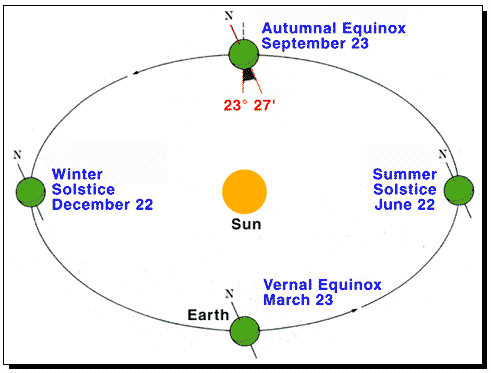
The direction of Earth's rotation axis is almost fixed in space. The axis is tilted by about 23 degrees so that it is not perpendicular to the plane of the orbit. As the Earth goes round its orbit, the North and South poles are alternately tilted towards the Sun. This is what causes the change in seasons.
Examining the ocean floor had many benefits to science. For geologists, it was the final piece of a puzzle that would explain how the Earth might be constructed. Their model started with an extremely hot core of dense iron and radioactive (heavy) elements. Encapsulating this hot and dense core, there is a thick liquid made of molten minerals called magma-- the same red material that oozes out of volcanoes as lava. A good part of our planet is made of this magma (called the mantle, which is thousands of kilometers thick). Surrounding this mantle is a thin crust of colder, solid minerals. This crust is like a thin skin that floats on the fluid magma. The skin is cracked and broken into several sections called "plates." We all live on this thin crust, on one of these plates.
Scientists often make the analogy to a loose skin surrounding an orange. Some prefer the over-ripe avocado analogy because it has the hard central "seed" like the Earth's core.
When atmospheric water condenses and forms the oceans, it collects like huge puddles on this thin skin (some, kilometers deep), depressing and compressing the crust. Areas that are free of this prodigious weight of water rise and form continents. Flaws in this delicate layer can result in volcanoes, and we now know that these can occur in the deepest oceans as well as on land.
It was this "floating" of the Earth's crust that first sparked Hapgood's interest, and lead him to the ideas of Hugh Achincloss Brown. Brown had theorized that the entire earth could be made to be repositioned at a radically new angle on its axis of rotation. In other words, the Earth could change angle of its spin relative to the orbit around the Sun. Brown tried to use this argument to explain climatic changes, but his theory failed the test of mathematics.
Brown's idea was not a new one. Some of the greatest geologists of the time, including J.C.Maxwell and Sir George Darwin (son of the famous Charles Darwin), considered this possibility, and decided that the stabilizing effect of the equatorial bulge was so great that no conceivable force originating within the Earth could make it shift on its axis, except for the collision with another planet. They, therefore, dismissed the idea of any shift of the poles as impossible and, in fact, not worth discussing. Their influence has been so pervasive that, to this day, no one has seriously considered such an hypothesis.
Hapgood, too, accepted the assumption that only a planetary collision is capable of displacing the axis of rotation. He proposed a theory that explained the shift of the poles as the result of the shift of the whole Earth's crust. The disturbances needed to slide the Earth's crust were far less than those needed to tilt the entire planet-- core and all.
Based on the research of the Russian scientist V.V. Beloussov, he assumed that at a depth of a hundred miles or so, in the upper mantle, there is a layer of liquid rock (magma) which behaves as a bearing, allowing the whole crust to shift when subjected to a displacing force. In Hapgood's opinion, this force is provided by the centrifugal momentum of ice caps eccentric to the poles. In other words, the weight of the ice on the poles is off-balancing the Earth's own daily rotation. Eventually, this imbalance gets to the point where a change occurs. According to Hapgood, the Earth keeps its axis of rotation unchanged, but the poles, and the whole Earth's surface, slide and change latitude. For a while, the Earth is balanced.
Hapgood realized that the entire planet did not need to be repositioned around its axis to maintain its balance. Only the outer crust needed to move, just as the loosely peeled skin of an orange (or avocado) could be slid around the stationary inner fruit. This line of thinking was published in Earth's Shifting Crust, in collaboration with James H. Campbell, a mathematician-engineer. Hapgood then proposed looking for Atlantis in a place where no one had ever suspected-- Antarctica.
Hapgoods reasoning went like this: He envisioned a catastrophic and dramatic move of the entire skin which allowed thick polar ice caps to melt in their new, warmer climate. Ice would again began to build up at the new poles, awaiting the next shift. In this scenario, Atlantis was repositioned to become a frozen and inhospitable continent, while the changing ocean levels reflected the amount of water locked up in the form of ice.
Since Plato's Atlantis was in the center of "the great ocean," Hapgood summarized that Antarctica would have been a perfect candidate for the lost continent, especially if it had it once been in a more Northern and moderate climate. Moreover, the legends of a catastrophic end to this advanced civilization could be descriptive of an abrupt continental slippage. If this is true, then we might well find our long lost mariners and mathematicians under the kilometers of ice that now cover the South Pole.
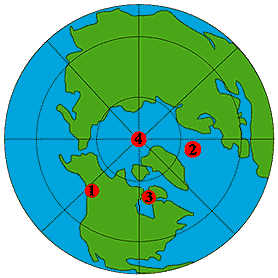 Looking down on the current North Pole, we can identify at least 3 previous positions of the pole according to Hapgood. These are shown roughly by the numbered red dots.
Looking down on the current North Pole, we can identify at least 3 previous positions of the pole according to Hapgood. These are shown roughly by the numbered red dots.
The evidence proving that the poles where in different positions during the Pleistocene era is quite impressive, and this explains why Hapgood's theory was approved by scientists such as Einstein and K.F. Mather. But his theory meets with so many difficulties that it beomes highly controversial. Above all, it seems to conflict with widely accepted theories, such as the drift of the continents. Hapgood, while credited with plotting the positions of past polar coordinates, was forced to adhere to a much slower transition of the poles, accepting the paradigm of continental drift and plate tectonics to maintain the support of the scientific community.
Ironically, one of the most recent objections to Hapgood's theory is the rapidity of climate changes that occurred in the Pleistocene period. According to Hapgood's revised theory, it took the North Pole at least two thousand years to move from its previous position to the present. The evidence we now have, however, definitely points to much faster climatic changes. It was Hapgood himself who first underscored the enormous amount of evidence proving the high speed at which the shift of the poles appears to have happened; speed which the mechanism of continental drift is unable to explain.
The only way to completely and coherently explain what took place at the end of Pleistocene appears to be that of admitting the possibility of a shift of the poles of the same magnitude Hapgood hypothesizes, but in a much shorter time: not more than a few days! This possibility is openly refused, only because no convincing explanation has been forwarded so far. It would, however, support the abrupt disaster the befell Atlantis-- if it is under Antarctica's polar ice cap. With no hard data to explain this extremely abrupt disturbance in geography, Hapgood continued aligned with the theory of a gradual shift. In the forward to a book on the subject, Hapgood wrote:
"Polar wandering is based on the idea that the outer shell of the earth shifts about from time to time, moving some continents toward and other continents away from the poles. Continental drift is based on the idea that the continents move individually... A few writers have suggested that perhaps continental drift causes polar wandering. This book advances the notion that polar wandering is primary and causes the displacement of continents.... This book will present evidence that the last shift of the earth's crust (the lithosphere) took place in recent time, at the close of the last ice age, and that it was the cause of the improvement in climate."(The Path of the Pole by Chilton.)

Based primarily on accepted, technical data, Hapgood argued that each shift took approximately 5,000 years, followed by 20,000 to 30,000 year periods with no polar movements. Also, in his calculations, the area of movement never covered more than 40 degrees.
Using geomagnetic and carbon dating evidence, he identified the locations of the pole and its paths.
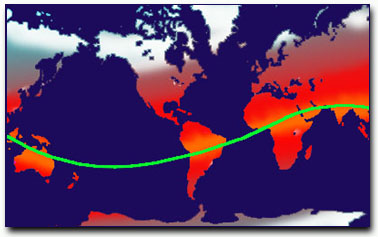
Position #1
63 degrees N, 135 degrees W. From the Yukon area of North America at about
80,000 B.P.(before present era) and moving east by 75,000 B.P
to the Greenland Sea.
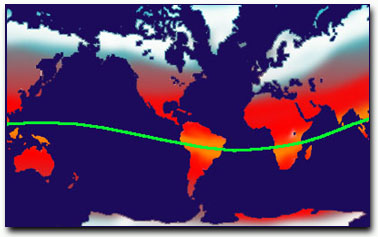
Position #2
72 degrees N, 10 degrees E. From the Greenland Sea, starting at about
55,000 B.P. and then moving south-west by 50,000 B.P.
towards what is now Hudson Bay.
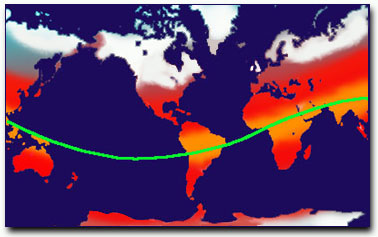
Position #3
60 degrees N, 73 degrees W. From the Hudson Bay area at about 17,000 B.P. and moving north to its present location by about 12,000 B.P.
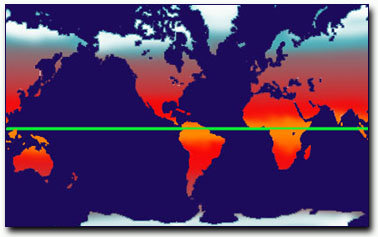
Position #4
The current position. When and where will the next shift occur?
If the poles shift even as little (within 40 degrees) as Hapgood argues, then the equator moves in significant ways. (This is shown by the green lines on the familiar maps the globe, above). This line traces the equator for each of the past polar positions. Notice the effects such polar shifts would have upon climate for various regions of the world. The changes in position are especially noticeable by where the equator cuts across the African continent in each situation-- high, diagonally or low, compared to today.
Some supportive historical facts were given by Hapgood to support these shifts in continental position and climate:
- The presence of ice caps in North America and Northern Europe, highly eccentric compared to the present north pole.
- The contemporaneous absence of ice caps from Siberia, which was actually populated to its northernmost regions by an impressive zoological community.
- The Arctic Sea was warmer than it is today, and there were human beings living in the New Siberia Islands.
- Antarctica was partially free of ice.
- The general climatic situation of the Earth was coherent with a different position of the poles.
So, while debate continues on the speed at which the poles have changed, the fact of their shift seems well established. It also appears that the shift will continue, as it likely has for millennia, as part of a cycle we are just now beginning to understand.





No comments:
Post a Comment